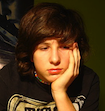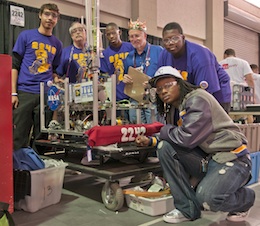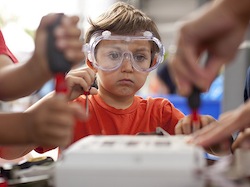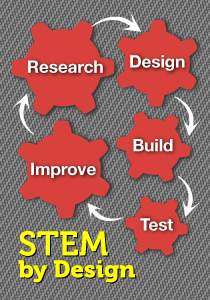Resolved: Excite Every Learner!
A MiddleWeb Blog
I remember walking through the office area with a bounce in my step – the holiday spirit everywhere! Student-made seasonal cards glittered on bulletin boards, a lighted tree sparkled in the office, and smiles issued from office personnel, administrators, and teachers alike.
My eyes rested on a figure huddled in a corner chair, as far away from the festive atmosphere as he could get. Head down. Red-faced. Anger, frustration, and depression spilling out over the waiting area. I paused as I recognized William. I’d taught William the previous year, or at least, I had tried to teach William. He failed to pass his eighth grade work — primarily because he failed to do any work, and now he’d joined the list of repeaters.
As I considered his six-foot frame, hunched over the beat-up trombone case on which he rested his head, I was hit with a fresh sense of failure. William had an IQ of 140 plus. His major interest seemed to be in proving to everyone – parents, teachers, and administrators – that he didn’t have to do anything. He developed “passive resistance” into a finely tuned art. William’s interests also extended to creating frequent class disruptions and alienating everyone around him, including peers.

I walked over to William. He didn’t look up, even when I asked, “What’s going on, Will?” He just mumbled bitterly, “I’ve been suspended.”
Suspended. Again. A sense of heaviness settled over my lighthearted mood. William’s transfer to this school was already in jeopardy. I sat down and chatted informally with him. I learned that he liked to begin novels, but did not finish them. He hated school because he felt bored and out of place. He was continually at odds with his family.

His head dropped again, but his body language said: “Go on. I’m listening.”
“Work with us, Will,” I appealed, “For yourself and for the sake of other kids like you. Help us find some ON buttons. Help us figure out what the ideal school for kids like you would look like.”
He never answered. When William came back after his suspension, he behaved in the same manner – the same way he’s behaved since kindergarten. And his teachers probably offered the same responses. No shift in anyone’s modus operandi. And none of us had heard of STEM.
Why STEM might have made a difference
Sometimes, considering kids like William, the reality of what teachers face in helping students learn every day seems overwhelming Looking back on that day 10 years ago, I wish I had known about the STEM approach to teaching and learning. We have real evidence that this approach can work – and really work well.

And no wonder. STEM lessons employ a wide array of strategies that have previously been used to meet the needs of academically talented students in schools. With STEM, all students can apply math, science, and technology in real-case scenarios. They all act as engineers and designers and create solutions. They practice working in teams to communicate ideas, respect one another and share success.
3 things I wonder about
Change is hard. “Going it alone” doesn’t work anymore. (As if it ever did.) That’s why teacher teaming to implement STEM lessons is critical piece of the picture. It will take all teachers working together to learn how to engage all students in STEM/problem-based learning.
I wonder . . .
- What would effective education and schooling look like if all schools did this?
- What would school systems, administrators, and teachers need to do differently?
- How can we build full, enthusiastic teacher participation in the STEM process?
My New Year’s Resolution

I resolve to continue trying to establish a sustained, engaging process that leads to high quality student learning and provides ongoing support for teachers to share, grow, and learn.
That’s educationese for: “Heck! I care so much about this remarkable teaching vocation, with its amazing moments and its mind-bending challenges. I care so much about teachers, who are literally shaping and saving lives. I am captivated by the magic that occurs when the light comes on for students and they really begin to learn and grow. And I grieve when I look at situations that keep teachers from doing what they have given their lives to do — and that prevent students like William from learning as they should. I’ll probably spend every day the rest of my life trying to make education better.
I think STEM is a big part of the solution for students and teachers today. Authentic teacher collaboration is another important piece. So those two things will continue to be my personal focus.
If my resolution seems idealistic, I make no apologies for that. But at least it’s less idealistic than my usual resolution to exercise and lose weight. Happy New Year!





























